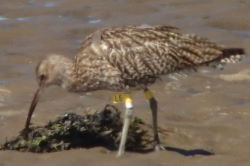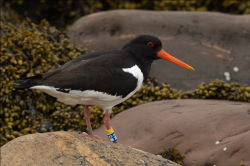Oystercatchers on the move
As to be expected at this time of year, Oystercatchers are starting to leave the Exe Estuary and return to their breeding sites. One of the advantages of having a colour-marked population is that we can track the timing of this migration. In the past week five different birds have been reported from the north of England.
On 16 February, M7 and WASP thin-thick-thick were back at Carsington Water in Derbyshire, where we believe they are paired and breed. On the following day A0 was seen at Dunsop Bridge in Lancashire. On 19 February, 2H was in the Lower Derwent Valley in North Yorkshire and two days later V5 was on another nature reserve, Nosterfield LNR, near Ripon also in North Yorkshire.
Curlew returning to the Taw-Torridge after breeding season
 Curlew Yellow flag L5 © R JutsumThree male Curlew from the small Severn and Avon Vales breeding population have been recorded on the Taw-Torridge estuary in the past two weeks. It is likely that they will stay for the winter as Curlew are very faithful to both breeding and wintering sites. All are marked with yellow leg flags bearing a two-character inscription. Two of these (AL and AP) have been located on the estuary via GPS trackers fitted on their breeding grounds and a third (L5) was re-sighted by a local birder. We would welcome further reports of these birds by email to the This email address is being protected from spambots. You need JavaScript enabled to view it. or by completing the form on the EURING website.
Curlew Yellow flag L5 © R JutsumThree male Curlew from the small Severn and Avon Vales breeding population have been recorded on the Taw-Torridge estuary in the past two weeks. It is likely that they will stay for the winter as Curlew are very faithful to both breeding and wintering sites. All are marked with yellow leg flags bearing a two-character inscription. Two of these (AL and AP) have been located on the estuary via GPS trackers fitted on their breeding grounds and a third (L5) was re-sighted by a local birder. We would welcome further reports of these birds by email to the This email address is being protected from spambots. You need JavaScript enabled to view it. or by completing the form on the EURING website.
Exe Estuary Dunlin reported in North-east Iceland
Although we have ringed relatively few Dunlin, we have started colour ringing them to investigate the wintering site turnover, fidelity and habitat use. As an unexpected bonus one of these birds ringed in October 2021 has been reported this month in north-east Iceland. The life history and map can be viewed here.
North Devon tagged Curlew leave for breeding sites
Two Curlew fitted with tags provided by Rijkswaterstaat/Bureau Waardenburg at The Skern, Northam on 7 November 2021 have now departed from the Taw-Torridge for their breeding grounds. One seems to be settled in Gloucestershire and the other is in County Durham.
Exe Estuary Oystercatcher breeding in Finnmark
 Oystercatcher M5 breeding in Norway © Knut-Sverre HornOf the thousands of sightings of the colour-ringed Oystercatcher of this project, a sighting of 'M5' by Knut-Sverre Horn is one of the most extraordinary. It was re-sighted on 6 June 2020 apparently with a mate at Ekkerøy in Finnmark, northern Norway. Since February 2018, there have been three other Oystercatcher seen on breeding sites in Norway, but these sites are in the far southwest of the country, around the coast about a 1,000 miles away. In a straight line, the sighting of 'M5' is more than 1,700 miles (2,200 miles around the coasts) from Dawlish Warren, where it was ringed on 4 February 2018.
Oystercatcher M5 breeding in Norway © Knut-Sverre HornOf the thousands of sightings of the colour-ringed Oystercatcher of this project, a sighting of 'M5' by Knut-Sverre Horn is one of the most extraordinary. It was re-sighted on 6 June 2020 apparently with a mate at Ekkerøy in Finnmark, northern Norway. Since February 2018, there have been three other Oystercatcher seen on breeding sites in Norway, but these sites are in the far southwest of the country, around the coast about a 1,000 miles away. In a straight line, the sighting of 'M5' is more than 1,700 miles (2,200 miles around the coasts) from Dawlish Warren, where it was ringed on 4 February 2018.
After ringing, 'M5' remained on the Exe Estuary until 24 March 2018, then after the breeding season re-appeared on 17 August 2018 to spend the winter on the Exe Estuary until 21 March 2019. Again, it re-appeared after the breeding season on 9 Aug 2019 and we last saw it on 8 March 2020. Over the winters has not been seen before further than 2 miles away from where it was ringed!
The full life-history of this bird and a map of its known movements can be seen here.
Annual Reports
| 2018 Annual Report |
| 2019 Annual Report |
